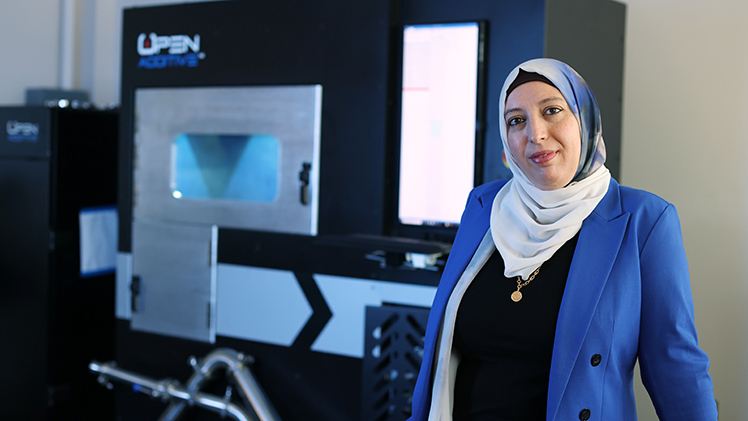Origami has emerged as a point of interest for engineers, who draw inspiration from its strategic folds to create innovative structures that expand and contract to meet the unique needs of environments that range from the inner workings of the human body to outer space.
The University of Toledo’s Dr. Ala Qattawi is one of these engineers. She’s spent more than a decade exploring how origami techniques can advance manufacturing.
Now, with the support of a five-year, $500,000 award through the National Science Foundation’s Faculty Early Career Development (CAREER) Program, she’s taking this interest a step further by developing cutting-edge metal structures that can shift in and out of intricate origami-inspired shapes in response to fluctuations in temperature.

Dr. Ala Qattawi, an associate professor in the Department of Mechanical, Industrial and Manufacturing Engineering recently received an NSF CAREER Award.
“Engineers have developed adaptive origami for polymers and composite materials, but we’ll be breaking new ground in developing this technology for metals,” said Qattawi, an associate professor in the Department of Mechanical, Industrial and Manufacturing Engineering. “Metal is an attractive material because it can withstand strong impacts and high temperatures that polymers cannot, so it will open new opportunities for this technology.”
CAREER Awards are among the National Science Foundation’s most prestigious honors, supporting early-career faculty who have the potential to serve as academic role models in research and education and to lead advances in the mission of their department or organization.
In addition to supporting her and two graduate students in researching adaptive metal origami, Qattawi’s award also supports outreach to undergraduate students. She’ll incorporate lessons based on her work into two engineering courses — Additive Manufacturing and Manufacturing Processes — as a means to introduce undergraduate students both to the cutting-edge techniques she’s studying and the opportunities and challenges of hands-on research more generally.
“It’s very exciting to receive this CAREER Award,” Qattawi said. “To be able to focus on a topic for five years is a valuable opportunity for both me and the students I’ll be working with in the lab and in my undergraduate courses.”
Qattawi holds a bachelor’s degree in industrial engineering from Jordan University of Science and Technology and a doctoral degree in automotive engineering from Clemson University, where a tour of the nearby BMW factory early in her academic program made a strong impression with its carefully choreographed automation and cemented her interest in manufacturing processes.
Her doctoral dissertation focused on the applications of origami techniques of sheet metals, expertise she brought to UToledo when she joined the College of Engineering faculty in 2019. Since then, she’s expanded her research portfolio to additionally explore laser-based additive manufacturing and shape memory alloys.
Laser-based additive manufacturing, also known as laser powder bed fusion, is a type of 3D printing that utilizes a laser to melt and fuse powdered metals. This advanced manufacturing process allows for geometrically complex structures.
Meanwhile shape memory alloys are “smart” materials that respond to fluctuations in temperature, shifting shape when cold and returning to their original state when heated.
Qattawi integrates each of these research areas into her project supported by the NSF CAREER Award. Adaptive metal origami leverages the unique properties of each metal alloy that’s carefully layered within a structure. Each alloy responds differently to temperature triggers, allowing for adaptive and responsive structures that fold and unfold by design.
Eventual applications could include actuation and control functions in industries such as aerospace, biomedicine, construction, robotics and defense industrial sectors.
“Imagine a robot that can squeeze then unsqueeze to pass through a small space,” Qattawi suggested. “Or a surgical tool that responds to the temperature of the human body. There are a lot of directions we can take this research.”